Giải Toán 10 Bài 5: Tích của một số với một vectơ CD
Giải Toán 10 Bài 5 Chương 4 CD
Giải Toán 10 Bài 5: Tích của một số với một vectơ CD được VnDoc.com sưu tầm và xin gửi tới bạn đọc cùng tham khảo. Mời các bạn cùng theo dõi chi tiết bài viết dưới đây.
Bài 1 trang 92 SGK Toán 10 CD
Cho hình thang MNPQ, MN // PQ, MN = 2PQ. Phát biểu nào sau đây là đúng?
A. ![]() \(\overrightarrow {MN} = 2\overrightarrow {PQ}\)
\(\overrightarrow {MN} = 2\overrightarrow {PQ}\)
B. ![]() \(\overrightarrow {MN} = 2\overrightarrow {NP}\)
\(\overrightarrow {MN} = 2\overrightarrow {NP}\)
C. ![]() \(\overrightarrow {MN} = - 2\overrightarrow {PQ}\)
\(\overrightarrow {MN} = - 2\overrightarrow {PQ}\)
D. ![]() \(\overrightarrow {MQ} = - 2\overrightarrow {NP}\)
\(\overrightarrow {MQ} = - 2\overrightarrow {NP}\)
Lời giải
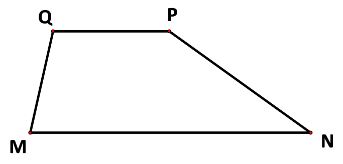
Do MQ và PN không song song với nhau nên ![]() \(\overrightarrow {MQ} \ne k\overrightarrow {NP}\). Vậy loại B và D.
\(\overrightarrow {MQ} \ne k\overrightarrow {NP}\). Vậy loại B và D.
Ta có: ![]() \(\overrightarrow {MN} ,\overrightarrow {PQ}\)là hai vecto ngược hướng và
\(\overrightarrow {MN} ,\overrightarrow {PQ}\)là hai vecto ngược hướng và ![]() \(\left| {\overrightarrow {MN} } \right| = 2\left| {\overrightarrow {PQ} } \right|\)
\(\left| {\overrightarrow {MN} } \right| = 2\left| {\overrightarrow {PQ} } \right|\)
Suy ra ![]() \(\overrightarrow {MN} = - 2\overrightarrow {PQ}\)
\(\overrightarrow {MN} = - 2\overrightarrow {PQ}\)
Vậy chọn C.
Bài 2 trang 92 SGK Toán 10 CD
Cho đoạn thẳng AB = 6 cm.
a) Xác định điểm C thỏa mãn ![]() \(\overrightarrow {AC} = \frac{1}{2}\overrightarrow {AB}\)
\(\overrightarrow {AC} = \frac{1}{2}\overrightarrow {AB}\)
b) Xác định điểm D thỏa mãn ![]() \(\overrightarrow {AD} = - \frac{1}{2}\overrightarrow {AB}\)
\(\overrightarrow {AD} = - \frac{1}{2}\overrightarrow {AB}\)
Lời giải
a) Ta có: ![]() \(\overrightarrow {AC} = \frac{1}{2}\overrightarrow {AB}\)
\(\overrightarrow {AC} = \frac{1}{2}\overrightarrow {AB}\)
![]() \(\Rightarrow\) Hai vecto
\(\Rightarrow\) Hai vecto ![]() \(\overrightarrow {AB} ,\overrightarrow {AC}\) cùng hướng và
\(\overrightarrow {AB} ,\overrightarrow {AC}\) cùng hướng và ![]() \(AC = \frac{1}{2}AB.\)
\(AC = \frac{1}{2}AB.\)
![]()
Vậy C là trung điểm của AB.
b) Ta có: ![]() \(\overrightarrow {AD} = - \frac{1}{2}\overrightarrow {AB} = - \overrightarrow {AC}\)
\(\overrightarrow {AD} = - \frac{1}{2}\overrightarrow {AB} = - \overrightarrow {AC}\)
![]() \(\Rightarrow\) Hai vecto
\(\Rightarrow\) Hai vecto ![]() \(\overrightarrow {AD} ,\overrightarrow {AC}\) ngược hướng và AD = AC.
\(\overrightarrow {AD} ,\overrightarrow {AC}\) ngược hướng và AD = AC.
![]()
Vậy A là trung điểm DC.
Bài 3 trang 92 SGK Toán 10 CD
Cho tam giác ABC có M, N, P lần lượt là trung điểm của BC, CA, AB. Chứng minh:
a) ![]() \(\overrightarrow {AP} + \frac{1}{2}\overrightarrow {BC} = \overrightarrow {AN}\)
\(\overrightarrow {AP} + \frac{1}{2}\overrightarrow {BC} = \overrightarrow {AN}\)
b) ![]() \(\overrightarrow {BC} + 2\overrightarrow {MP} = \overrightarrow {BA}\)
\(\overrightarrow {BC} + 2\overrightarrow {MP} = \overrightarrow {BA}\)
Lời giải
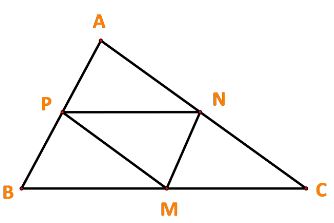
a) Ta có: ![]() \(\overrightarrow {BC} ,\overrightarrow {PN}\)là hai vecto cùng hướng và
\(\overrightarrow {BC} ,\overrightarrow {PN}\)là hai vecto cùng hướng và ![]() \(\frac{1}{2}\left| {\overrightarrow {BC} } \right| = \left| {\overrightarrow {PN} } \right|\)
\(\frac{1}{2}\left| {\overrightarrow {BC} } \right| = \left| {\overrightarrow {PN} } \right|\)
![]() \(\Rightarrow\)
\(\Rightarrow\) ![]() \(\frac{1}{2}\overrightarrow {BC} = \overrightarrow {PN} \Rightarrow \overrightarrow {AP} + \frac{1}{2}\overrightarrow {BC} = \overrightarrow {AP} + \overrightarrow {PN} = \overrightarrow {AN}\)
\(\frac{1}{2}\overrightarrow {BC} = \overrightarrow {PN} \Rightarrow \overrightarrow {AP} + \frac{1}{2}\overrightarrow {BC} = \overrightarrow {AP} + \overrightarrow {PN} = \overrightarrow {AN}\)
b) Ta có: ![]() \(\overrightarrow {MP} ,\overrightarrow {CA}\)là hai vecto cùng hướng và
\(\overrightarrow {MP} ,\overrightarrow {CA}\)là hai vecto cùng hướng và ![]() \(2\left| {\overrightarrow {MP} } \right| = \left| {\overrightarrow {CA} } \right|\)
\(2\left| {\overrightarrow {MP} } \right| = \left| {\overrightarrow {CA} } \right|\)
![]() \(\Rightarrow 2\overrightarrow {MP} = \overrightarrow {CA} \Rightarrow \overrightarrow {BC} + 2\overrightarrow {MP} = \overrightarrow {BC} + \overrightarrow {CA} = \overrightarrow {BA}\)
\(\Rightarrow 2\overrightarrow {MP} = \overrightarrow {CA} \Rightarrow \overrightarrow {BC} + 2\overrightarrow {MP} = \overrightarrow {BC} + \overrightarrow {CA} = \overrightarrow {BA}\)
Bài 4 trang 92 SGK Toán 10 CD
Cho tam giác ABC. Các điểm D, E thuộc cạnh BC thỏa mãn BD = DE = EC (Hình 62). Giả sử ![]() \(\overrightarrow {AB} = \overrightarrow a ,\overrightarrow {AC} = \overrightarrow b\) . Biểu diễn các vecto
\(\overrightarrow {AB} = \overrightarrow a ,\overrightarrow {AC} = \overrightarrow b\) . Biểu diễn các vecto ![]() \(\overrightarrow {BC} ,\overrightarrow {BD} ,\overrightarrow {BE} ,\overrightarrow {AD} ,\overrightarrow {AE}\) theo
\(\overrightarrow {BC} ,\overrightarrow {BD} ,\overrightarrow {BE} ,\overrightarrow {AD} ,\overrightarrow {AE}\) theo ![]() \(\overrightarrow a ,\overrightarrow b .\)
\(\overrightarrow a ,\overrightarrow b .\)

Lời giải
Ta có: ![]() \(\overrightarrow {AB} + \overrightarrow {BC} = \overrightarrow {AC} \Leftrightarrow \overrightarrow {BC} = \overrightarrow b - \overrightarrow a\)
\(\overrightarrow {AB} + \overrightarrow {BC} = \overrightarrow {AC} \Leftrightarrow \overrightarrow {BC} = \overrightarrow b - \overrightarrow a\)
Lại có: vecto ![]() \(\overrightarrow {BD} ,\overrightarrow {BC}\)cùng hướng và
\(\overrightarrow {BD} ,\overrightarrow {BC}\)cùng hướng và ![]() \(\left| {\overrightarrow {BD} } \right| = \frac{1}{3}\left| {\overrightarrow {BC} } \right|\)
\(\left| {\overrightarrow {BD} } \right| = \frac{1}{3}\left| {\overrightarrow {BC} } \right|\)
![]() \(\Rightarrow \overrightarrow {BD} = \frac{1}{3}\overrightarrow {BC} = \frac{1}{3}(\overrightarrow b - \overrightarrow a )\)
\(\Rightarrow \overrightarrow {BD} = \frac{1}{3}\overrightarrow {BC} = \frac{1}{3}(\overrightarrow b - \overrightarrow a )\)
Tương tự: vecto ![]() \(\overrightarrow {BE} ,\overrightarrow {BC}\)cùng hướng và
\(\overrightarrow {BE} ,\overrightarrow {BC}\)cùng hướng và ![]() \(\left| {\overrightarrow {BE} } \right| = \frac{2}{3}\left| {\overrightarrow {BC} } \right|\)
\(\left| {\overrightarrow {BE} } \right| = \frac{2}{3}\left| {\overrightarrow {BC} } \right|\)
![]() \(\Rightarrow \overrightarrow {BE} = \frac{2}{3}\overrightarrow {BC} = \frac{2}{3}(\overrightarrow b - \overrightarrow a )\)
\(\Rightarrow \overrightarrow {BE} = \frac{2}{3}\overrightarrow {BC} = \frac{2}{3}(\overrightarrow b - \overrightarrow a )\)
Ta có:
![]() \(\overrightarrow {AB} + \overrightarrow {BD} = \overrightarrow {AD} \Leftrightarrow \overrightarrow {AD} = \overrightarrow a + \frac{1}{3}(\overrightarrow b - \overrightarrow a ) = \frac{2}{3}\overrightarrow a + \frac{1}{3}\overrightarrow b\)
\(\overrightarrow {AB} + \overrightarrow {BD} = \overrightarrow {AD} \Leftrightarrow \overrightarrow {AD} = \overrightarrow a + \frac{1}{3}(\overrightarrow b - \overrightarrow a ) = \frac{2}{3}\overrightarrow a + \frac{1}{3}\overrightarrow b\)
![]() \(\overrightarrow {AB} + \overrightarrow {BE} = \overrightarrow {AE} \Leftrightarrow \overrightarrow {AE} = \overrightarrow a + \frac{2}{3}(\overrightarrow b - \overrightarrow a ) = \frac{1}{3}\overrightarrow a + \frac{2}{3}\overrightarrow b\)
\(\overrightarrow {AB} + \overrightarrow {BE} = \overrightarrow {AE} \Leftrightarrow \overrightarrow {AE} = \overrightarrow a + \frac{2}{3}(\overrightarrow b - \overrightarrow a ) = \frac{1}{3}\overrightarrow a + \frac{2}{3}\overrightarrow b\)
Bài 5 trang 92 SGK Toán 10 CD
Cho tứ giác ABCD có M, N lần lượt là trung điểm của hai cạnh AB và CD. Gọi G là trung điểm của đoạn thẳng MN, E là trọng tâm tam giác BCD. Chứng minh:
a) ![]() \(\overrightarrow {EA} + \overrightarrow {EB} + \overrightarrow {EC} + \overrightarrow {ED} = 4\overrightarrow {EG}\)
\(\overrightarrow {EA} + \overrightarrow {EB} + \overrightarrow {EC} + \overrightarrow {ED} = 4\overrightarrow {EG}\)
b) ![]() \(\overrightarrow {EA} = 4\overrightarrow {EG}\)
\(\overrightarrow {EA} = 4\overrightarrow {EG}\)
c) Điểm G thuộc đoạn thẳng AE và ![]() \(\overrightarrow {AG} = \frac{3}{4}\overrightarrow {AE}\)
\(\overrightarrow {AG} = \frac{3}{4}\overrightarrow {AE}\)
Lời giải
a) Ta có: ![]() \(\overrightarrow {EA} + \overrightarrow {EB} + \overrightarrow {EC} + \overrightarrow {ED} = 4\overrightarrow {EG} + \overrightarrow {GA} + \overrightarrow {GB} + \overrightarrow {GC} + \overrightarrow {GD}\)
\(\overrightarrow {EA} + \overrightarrow {EB} + \overrightarrow {EC} + \overrightarrow {ED} = 4\overrightarrow {EG} + \overrightarrow {GA} + \overrightarrow {GB} + \overrightarrow {GC} + \overrightarrow {GD}\)
Mà: ![]() \(\overrightarrow {GA} + \overrightarrow {GB} = 2\overrightarrow {GM}\); (do M là trung điểm của AB)
\(\overrightarrow {GA} + \overrightarrow {GB} = 2\overrightarrow {GM}\); (do M là trung điểm của AB)
![]() \(\overrightarrow {GC} + \overrightarrow {GD} = 2\overrightarrow {GN}\)(do N là trung điểm của CD)
\(\overrightarrow {GC} + \overrightarrow {GD} = 2\overrightarrow {GN}\)(do N là trung điểm của CD)
![]() \(\Rightarrow \overrightarrow {EA} + \overrightarrow {EB} + \overrightarrow {EC} + \overrightarrow {ED} = 4\overrightarrow {EG} + 2(\overrightarrow {GM} + \overrightarrow {GN} ) = 4\overrightarrow {EG}\)(do G là trung điểm của MN)
\(\Rightarrow \overrightarrow {EA} + \overrightarrow {EB} + \overrightarrow {EC} + \overrightarrow {ED} = 4\overrightarrow {EG} + 2(\overrightarrow {GM} + \overrightarrow {GN} ) = 4\overrightarrow {EG}\)(do G là trung điểm của MN)
b) Vì E là trọng tâm tam giác BCD nên ![]() \(\overrightarrow {EB} + \overrightarrow {EC} + \overrightarrow {ED} = \overrightarrow 0\)
\(\overrightarrow {EB} + \overrightarrow {EC} + \overrightarrow {ED} = \overrightarrow 0\)
Từ ý a ta suy ra ![]() \(\overrightarrow {EA} = 4\overrightarrow {EG}\)
\(\overrightarrow {EA} = 4\overrightarrow {EG}\)
c) Ta có: ![]() \(\overrightarrow {EA} = 4\overrightarrow {EG} \Leftrightarrow \overrightarrow {EA} = 4.(\overrightarrow {EA} + \overrightarrow {AG} ) \Leftrightarrow - 3\overrightarrow {EA} = 4\overrightarrow {AG}\)
\(\overrightarrow {EA} = 4\overrightarrow {EG} \Leftrightarrow \overrightarrow {EA} = 4.(\overrightarrow {EA} + \overrightarrow {AG} ) \Leftrightarrow - 3\overrightarrow {EA} = 4\overrightarrow {AG}\)
![]() \(\Leftrightarrow 3\overrightarrow {AE} = 4\overrightarrow {AG}\)hay
\(\Leftrightarrow 3\overrightarrow {AE} = 4\overrightarrow {AG}\)hay ![]() \(\overrightarrow {AG} = \frac{3}{4}\overrightarrow {AE}\)
\(\overrightarrow {AG} = \frac{3}{4}\overrightarrow {AE}\)
Suy ra A, G, E thẳng hàng và ![]() \(AG = \frac{3}{4}AE\)nên G thuộc đoạn AE.
\(AG = \frac{3}{4}AE\)nên G thuộc đoạn AE.
Bài 6 trang 92 SGK Toán 10 CD
Cho ABCD là hình bình hành. Đặt ![]() \(\overrightarrow {AB} = \overrightarrow a ,\overrightarrow {AD} = \overrightarrow b\). Gọi G là trọng tâm của tam giác ABC. Biểu thị các vecto
\(\overrightarrow {AB} = \overrightarrow a ,\overrightarrow {AD} = \overrightarrow b\). Gọi G là trọng tâm của tam giác ABC. Biểu thị các vecto ![]() \(\overrightarrow {AG} ,\overrightarrow {CG}\) theo hai vecto
\(\overrightarrow {AG} ,\overrightarrow {CG}\) theo hai vecto ![]() \(\overrightarrow a ,\overrightarrow b\).
\(\overrightarrow a ,\overrightarrow b\).
Lời giải
Gọi O là giao điểm của AC và BD.
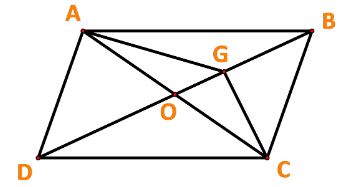
Ta có:
 \(\begin{array}{l}\overrightarrow {AG} = \overrightarrow {AB} + \overrightarrow {BG} = \overrightarrow a + \overrightarrow {BG} ;\\\overrightarrow {CG} = \overrightarrow {CB} + \overrightarrow {BG} = \overrightarrow {DA} + \overrightarrow {BG} = - \overrightarrow b + \overrightarrow {BG} ;\end{array}(*)\)
\(\begin{array}{l}\overrightarrow {AG} = \overrightarrow {AB} + \overrightarrow {BG} = \overrightarrow a + \overrightarrow {BG} ;\\\overrightarrow {CG} = \overrightarrow {CB} + \overrightarrow {BG} = \overrightarrow {DA} + \overrightarrow {BG} = - \overrightarrow b + \overrightarrow {BG} ;\end{array}(*)\)
Lại có: ![]() \(\overrightarrow {BD} =\overrightarrow {BA} + \overrightarrow {AD} = - \overrightarrow a + \overrightarrow b\).
\(\overrightarrow {BD} =\overrightarrow {BA} + \overrightarrow {AD} = - \overrightarrow a + \overrightarrow b\).
![]() \(\overrightarrow {BG} ,\overrightarrow {BD}\) cùng phương và
\(\overrightarrow {BG} ,\overrightarrow {BD}\) cùng phương và ![]() \(\left| {\overrightarrow {BG} } \right| = \frac{2}{3}BO = \frac{1}{3}\left| {\overrightarrow {BD} } \right|\)
\(\left| {\overrightarrow {BG} } \right| = \frac{2}{3}BO = \frac{1}{3}\left| {\overrightarrow {BD} } \right|\)
![]() \(\Rightarrow \overrightarrow {BG} = \frac{1}{3}\overrightarrow {BD} = \frac{1}{3}\left( { - \overrightarrow a + \overrightarrow b } \right)\)
\(\Rightarrow \overrightarrow {BG} = \frac{1}{3}\overrightarrow {BD} = \frac{1}{3}\left( { - \overrightarrow a + \overrightarrow b } \right)\)
Do đó  \((*) \Leftrightarrow \left\{ \begin{array}{l}\overrightarrow {AG} = \overrightarrow a + \overrightarrow {BG} = \overrightarrow a + \frac{1}{3}\left( { - \overrightarrow a + \overrightarrow b } \right) = \frac{2}{3}\overrightarrow a + \frac{1}{3}\overrightarrow b ;\\\overrightarrow {CG} = -\overrightarrow b + \overrightarrow {BG} = -\overrightarrow b + \frac{1}{3}\left( { - \overrightarrow a + \overrightarrow b } \right) = - \frac{1}{3}\overrightarrow a - \frac{2}{3}\overrightarrow b ;\end{array} \right.\)
\((*) \Leftrightarrow \left\{ \begin{array}{l}\overrightarrow {AG} = \overrightarrow a + \overrightarrow {BG} = \overrightarrow a + \frac{1}{3}\left( { - \overrightarrow a + \overrightarrow b } \right) = \frac{2}{3}\overrightarrow a + \frac{1}{3}\overrightarrow b ;\\\overrightarrow {CG} = -\overrightarrow b + \overrightarrow {BG} = -\overrightarrow b + \frac{1}{3}\left( { - \overrightarrow a + \overrightarrow b } \right) = - \frac{1}{3}\overrightarrow a - \frac{2}{3}\overrightarrow b ;\end{array} \right.\)
Vậy ![]() \(\overrightarrow {AG} = \frac{2}{3}\overrightarrow a + \frac{1}{3}\overrightarrow b ;\;\overrightarrow {CG} = - \frac{1}{3}\overrightarrow a - \frac{2}{3}\overrightarrow b .\)
\(\overrightarrow {AG} = \frac{2}{3}\overrightarrow a + \frac{1}{3}\overrightarrow b ;\;\overrightarrow {CG} = - \frac{1}{3}\overrightarrow a - \frac{2}{3}\overrightarrow b .\)
Cách 2:
Gọi AE, CF là các trung tuyến trong tam giác ABC.
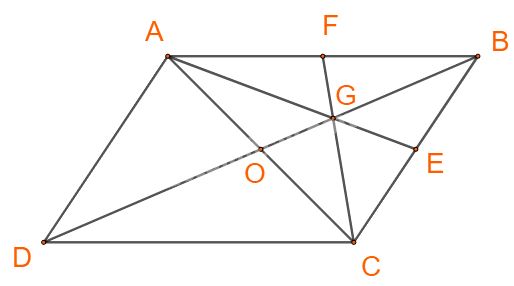
Ta có:
![]() \(\overrightarrow {AG} = \frac{2}{3}\overrightarrow {AE} = \frac{2}{3}.\frac{1}{2}\left( {\overrightarrow {AB} + \overrightarrow {AC} } \right) = \frac{2}{3}.\frac{1}{2}\left[ {\overrightarrow {AB} + \left( {\overrightarrow {AB} + \overrightarrow {AD} } \right)} \right]\)
\(\overrightarrow {AG} = \frac{2}{3}\overrightarrow {AE} = \frac{2}{3}.\frac{1}{2}\left( {\overrightarrow {AB} + \overrightarrow {AC} } \right) = \frac{2}{3}.\frac{1}{2}\left[ {\overrightarrow {AB} + \left( {\overrightarrow {AB} + \overrightarrow {AD} } \right)} \right]\)
![]() \(= \frac{1}{3}\left( {2\overrightarrow a + \overrightarrow b } \right) = \frac{2}{3}\overrightarrow a + \frac{1}{3}\overrightarrow b\)
\(= \frac{1}{3}\left( {2\overrightarrow a + \overrightarrow b } \right) = \frac{2}{3}\overrightarrow a + \frac{1}{3}\overrightarrow b\)
![]() \(\overrightarrow {CG} = \frac{2}{3}\overrightarrow {CF} = \frac{2}{3}.\frac{1}{2}\left( {\overrightarrow {CA} + \overrightarrow {CB} } \right) = \frac{2}{3}.\frac{1}{2}\left[ {\left( {\overrightarrow {CB} + \overrightarrow {CD} } \right) + \overrightarrow {CB} } \right]\)
\(\overrightarrow {CG} = \frac{2}{3}\overrightarrow {CF} = \frac{2}{3}.\frac{1}{2}\left( {\overrightarrow {CA} + \overrightarrow {CB} } \right) = \frac{2}{3}.\frac{1}{2}\left[ {\left( {\overrightarrow {CB} + \overrightarrow {CD} } \right) + \overrightarrow {CB} } \right]\)
![]() \(= \frac{1}{3}\left( {2\overrightarrow {CB} + \overrightarrow {CD} } \right) = \frac{1}{3}\left( { - 2\overrightarrow {AD} - \overrightarrow {AB} } \right) = - \frac{1}{3}\overrightarrow a - \frac{2}{3}\overrightarrow b\)
\(= \frac{1}{3}\left( {2\overrightarrow {CB} + \overrightarrow {CD} } \right) = \frac{1}{3}\left( { - 2\overrightarrow {AD} - \overrightarrow {AB} } \right) = - \frac{1}{3}\overrightarrow a - \frac{2}{3}\overrightarrow b\)
Vậy ![]() \(\overrightarrow {AG} = \frac{2}{3}\overrightarrow a + \frac{1}{3}\overrightarrow b ;\;\overrightarrow {CG} = - \frac{1}{3}\overrightarrow a - \frac{2}{3}\overrightarrow b .\)
\(\overrightarrow {AG} = \frac{2}{3}\overrightarrow a + \frac{1}{3}\overrightarrow b ;\;\overrightarrow {CG} = - \frac{1}{3}\overrightarrow a - \frac{2}{3}\overrightarrow b .\)
Bài 7 trang 92 SGK Toán 10 CD
Cho tam giác ABC. Các điểm D, E, H thỏa mãn
![]() \(\overrightarrow {DB} = \frac{1}{3}\overrightarrow {BC} ,\;\overrightarrow {AE} = \frac{1}{3}\overrightarrow {AC} ,\;\overrightarrow {AH} = \frac{2}{3}\overrightarrow {AB} .\)
\(\overrightarrow {DB} = \frac{1}{3}\overrightarrow {BC} ,\;\overrightarrow {AE} = \frac{1}{3}\overrightarrow {AC} ,\;\overrightarrow {AH} = \frac{2}{3}\overrightarrow {AB} .\)
a) Biểu thị mỗi vecto ![]() \(\overrightarrow {AD} ,\overrightarrow {DH} ,\overrightarrow {HE}\)theo hai vecto
\(\overrightarrow {AD} ,\overrightarrow {DH} ,\overrightarrow {HE}\)theo hai vecto ![]() \(\overrightarrow {AB} ,\overrightarrow {AC}\).
\(\overrightarrow {AB} ,\overrightarrow {AC}\).
b) Chứng minh D, E, H thẳng hàng.
Lời giải
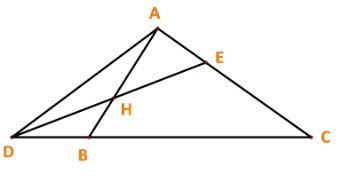
Dễ thấy: ![]() \(\overrightarrow {BC} = \overrightarrow {BA} + \overrightarrow {AC} = - \overrightarrow {AB} + \overrightarrow {AC}\)
\(\overrightarrow {BC} = \overrightarrow {BA} + \overrightarrow {AC} = - \overrightarrow {AB} + \overrightarrow {AC}\)
Ta có:
![]() \(+)\ \overrightarrow {AD} = \overrightarrow {AB} + \overrightarrow {BD} . Mà \overrightarrow {BD} = - \overrightarrow {DB} = - \frac{1}{3}\overrightarrow {BC}\)
\(+)\ \overrightarrow {AD} = \overrightarrow {AB} + \overrightarrow {BD} . Mà \overrightarrow {BD} = - \overrightarrow {DB} = - \frac{1}{3}\overrightarrow {BC}\)
![]() \(\Rightarrow \overrightarrow {AD} = \overrightarrow {AB} + \left( { - \frac{1}{3}} \right)( - \overrightarrow {AB} + \overrightarrow {AC} ) = \frac{4}{3}\overrightarrow {AB} - \frac{1}{3}\overrightarrow {AC}\)
\(\Rightarrow \overrightarrow {AD} = \overrightarrow {AB} + \left( { - \frac{1}{3}} \right)( - \overrightarrow {AB} + \overrightarrow {AC} ) = \frac{4}{3}\overrightarrow {AB} - \frac{1}{3}\overrightarrow {AC}\)
![]() \(+)\ \overrightarrow {DH} = \overrightarrow {DA} + \overrightarrow {AH} = - \overrightarrow {AD} + \overrightarrow {AH} .\)
\(+)\ \overrightarrow {DH} = \overrightarrow {DA} + \overrightarrow {AH} = - \overrightarrow {AD} + \overrightarrow {AH} .\)
Mà ![]() \(\overrightarrow {AD} = \frac{4}{3}\overrightarrow {AB} - \frac{1}{3}\overrightarrow {AC} ;\;\;\overrightarrow {AH} = \frac{2}{3}\overrightarrow {AB} .\)
\(\overrightarrow {AD} = \frac{4}{3}\overrightarrow {AB} - \frac{1}{3}\overrightarrow {AC} ;\;\;\overrightarrow {AH} = \frac{2}{3}\overrightarrow {AB} .\)
![]() \(\Rightarrow \overrightarrow {DH} = - \left( {\frac{4}{3}\overrightarrow {AB} - \frac{1}{3}\overrightarrow {AC} } \right) + \frac{2}{3}\overrightarrow {AB} = - \frac{2}{3}\overrightarrow {AB} + \frac{1}{3}\overrightarrow {AC} .\)
\(\Rightarrow \overrightarrow {DH} = - \left( {\frac{4}{3}\overrightarrow {AB} - \frac{1}{3}\overrightarrow {AC} } \right) + \frac{2}{3}\overrightarrow {AB} = - \frac{2}{3}\overrightarrow {AB} + \frac{1}{3}\overrightarrow {AC} .\)
![]() \(+)\ \overrightarrow {HE} = \overrightarrow {HA} + \overrightarrow {AE} = - \overrightarrow {AH} + \overrightarrow {AE}\)
\(+)\ \overrightarrow {HE} = \overrightarrow {HA} + \overrightarrow {AE} = - \overrightarrow {AH} + \overrightarrow {AE}\)
Mà ![]() \(\overrightarrow {AH} = \frac{2}{3}\overrightarrow {AB} ;\;\overrightarrow {AE} = \frac{1}{3}\overrightarrow {AC}\)
\(\overrightarrow {AH} = \frac{2}{3}\overrightarrow {AB} ;\;\overrightarrow {AE} = \frac{1}{3}\overrightarrow {AC}\)
![]() \(\Rightarrow \overrightarrow {HE} = - \frac{2}{3}\overrightarrow {AB} + \frac{1}{3}\overrightarrow {AC} .\)
\(\Rightarrow \overrightarrow {HE} = - \frac{2}{3}\overrightarrow {AB} + \frac{1}{3}\overrightarrow {AC} .\)
b)
Theo câu a, ta có: ![]() \(\overrightarrow {DH} = \overrightarrow {HE} = - \frac{2}{3}\overrightarrow {AB} + \frac{1}{3}\overrightarrow {AC}\)
\(\overrightarrow {DH} = \overrightarrow {HE} = - \frac{2}{3}\overrightarrow {AB} + \frac{1}{3}\overrightarrow {AC}\)
![]() \(\Rightarrow\) Hai vecto
\(\Rightarrow\) Hai vecto ![]() \(\overrightarrow {DH} ,\overrightarrow {HE}\)cùng phương.
\(\overrightarrow {DH} ,\overrightarrow {HE}\)cùng phương.
Trên đây VnDoc.com vừa gửi tới bạn đọc bài viết Giải Toán 10 Bài 5: Tích của một số với một vectơ CD. Hi vọng qua bài viết này bạn đọc có thêm nhiều tài liệu để học tập tốt hơn môn Toán 10 CD. Mời các bạn cùng tham khảo thêm tài liệu học tập các môn Ngữ văn 10 CD, Tiếng Anh 10...








